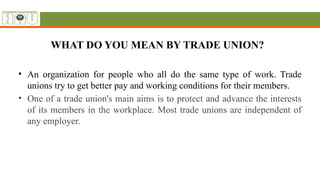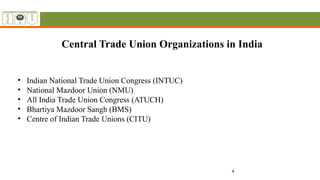TRADE UNION ACT 1926(Indian labor law).pptx
- 1. TRADE UNION ACT 1926 PRESENTED TO- DR. SUMAN GHALAWAT Assistant Professor, Department of Business Management PRESENTED BY-SUNAINA (2023A19MBA)
- 2. WHAT DO YOU MEAN BY TRADE UNION? • An organization for people who all do the same type of work. Trade unions try to get better pay and working conditions for their members. • One of a trade union's main aims is to protect and advance the interests of its members in the workplace. Most trade unions are independent of any employer.
- 3. 3 Objectives of Trade Union • To secure fair wages for workers and improve their opportunities for promotion and training. • To improve working and living conditions of the worker. • To protect the jobs of labor against retrenchment and layoffs. • To help them in improving levels of production, productivity, discipline and • high standard of living • To provide legal assistance to workers in connection with disputes regarding • work and payment of wages. • To promote individual and collective welfare and thus correlates the workers • interests with their industry.
- 4. 4 Central Trade Union Organizations in India • Indian National Trade Union Congress (INTUC) • National Mazdoor Union (NMU) • All India Trade Union Congress (ATUCH) • Bhartiya Mazdoor Sangh (BMS) • Centre of Indian Trade Unions (CITU)
- 5. 5 Registration of Trade Unions Appointment of Registrars. Mode of Registration. Application for Registration. Provisions to contained in the rules of a TU. Power to call for further particulars and to require alteration in name. Registration (Sec 8) Certificate of Registration. Cancellation of Registration.
- 6. 6 Registration of Trade Unions 1) Appointment of Registrars [Section 3] Government shall appoint a person to be the Registrar of Trade Unions for each State. 2.Mode of registration [Section 4] For the purpose of registration a minimum of seven members are necessary to form a trade union. Minimum 10% or 100 worker whichever is less are employed in the related industry or establishment.
- 7. 7 3. Application for Registration[Section 5] the names, occupations and addresses of the members making application. the name of the trade union and the address of its Head Office. the titles, names, ages, addresses and occupation of the Office Bearers of T.U. If Trade Union has already been existing for one year or more, for its registration the members should submit all the details- a) such as general statement of the assets and liabilities of the Trade Union going to be registered by the Registrar of Trade. 4.Provisions to be contained in the Rules of Trade Union [Section 6] Required to have written rules dealing with certain matters of every registered Trade Union These maters are specified in Schedule 2 of the Central trade Union Registration, 1938.
- 8. 8 5. Power to call for further particulars and to require alteration of name. |Section 7] (By Registrar) 6. Registration [Section 8] The Registrar will register the Trade Union. 7. Certificate of Registration [Section9] The Registrar registering a Trade Union under Section 8, shall issue a certificate of registration in the prescribed form. 8. Cancellation of registration [Section 10] When Trade Union registration certificate has been obtained by fraud or other illegal means Disobey the rules and regulation of Trade Union act, When there are no minimum required numbers of members in the Trade Union.
- 9. 9 Appeal [Section 11] If Registrar of the Trade Union stops registration of the Trade Union or withdrawal of the registration, members can appeal to Labor Court or an Industrial Tribunal, with in jurisdiction Court may dismiss the appeal, or pass an order directing the Registrar to register the Union and to issue a certificate of registration under the provisions of Section 9 or setting aside the order for withdrawal. Features of Registered Trade Union [Section 13] Registered Trade Union will have perpetual succession (will no stop after the death of the members of the Trade Union. Every registered Trade Union will have common seal. Every registered Trade Union can acquire and hold both movable and immovable property. Every registered Trade Union can sue others. Every registered Trade Union can sued by others also.
- 10. 10 Offences and Penalties [Sec 31-33) Offences- Failure to submit returns Supplying false information regarding Trade Unions Cognizance of offence Penalties- Fine up to Rs 50 + additional fine up to Rs 5 per week in case of continuing offence [Max. fine imposable Rs.50] Fine up to Rs 500, Fine up to Rs 500
- 11. 11 FUNCTIONS & ROLE OF TRADE UNIONS To improve working and living conditions To secure for workers fair wages To enlarge opportunities for promotion and training To promote individual and collective welfare. To provide for educational, cultural and recreational facilities. To safeguard security of tenure and improve conditions of service To promote identity of interests of the workers with their industry
- 12. THANK YOU





![6
Registration of Trade Unions
1) Appointment of Registrars [Section 3]
Government shall appoint a person to be the Registrar of Trade Unions for
each State.
2.Mode of registration [Section 4]
For the purpose of registration a minimum of seven members are necessary
to form a trade union.
Minimum 10% or 100 worker whichever is less are employed in the related
industry or establishment.](https://image.slidesharecdn.com/tradeunionact1926-1-250725102516-f45bdd69/85/TRADE-UNION-ACT-1926-Indian-labor-law-pptx-6-320.jpg)
![7
3. Application for Registration[Section 5]
the names, occupations and addresses of the members making application.
the name of the trade union and the address of its Head Office.
the titles, names, ages, addresses and occupation of the Office Bearers of T.U.
If Trade Union has already been existing for one year or more, for its registration
the members should submit all the details-
a) such as general statement of the assets and liabilities of the Trade Union going
to be registered by the Registrar of Trade.
4.Provisions to be contained in the Rules of Trade Union [Section 6]
Required to have written rules dealing with certain matters of every registered
Trade Union
These maters are specified in Schedule 2 of the Central trade Union Registration,
1938.](https://image.slidesharecdn.com/tradeunionact1926-1-250725102516-f45bdd69/85/TRADE-UNION-ACT-1926-Indian-labor-law-pptx-7-320.jpg)
![8
5. Power to call for further particulars and to require alteration of name. |Section 7]
(By Registrar)
6. Registration [Section 8]
The Registrar will register the Trade Union.
7. Certificate of Registration [Section9]
The Registrar registering a Trade Union under Section 8, shall issue a certificate of
registration in the prescribed form.
8. Cancellation of registration [Section 10]
When Trade Union registration certificate has been obtained by fraud or other
illegal means
Disobey the rules and regulation of Trade Union act,
When there are no minimum required numbers of members in the Trade Union.](https://image.slidesharecdn.com/tradeunionact1926-1-250725102516-f45bdd69/85/TRADE-UNION-ACT-1926-Indian-labor-law-pptx-8-320.jpg)
![9
Appeal [Section 11]
If Registrar of the Trade Union stops registration of the Trade Union or withdrawal of the
registration, members can appeal to Labor Court or an Industrial Tribunal, with in
jurisdiction Court may dismiss the appeal, or pass an order directing the Registrar to register
the Union and to issue a certificate of registration under the provisions of Section 9 or
setting aside the order for withdrawal.
Features of Registered Trade Union [Section 13]
Registered Trade Union will have perpetual succession (will no stop after the death of the
members of the Trade Union.
Every registered Trade Union will have common seal.
Every registered Trade Union can acquire and hold both movable and immovable
property.
Every registered Trade Union can sue others.
Every registered Trade Union can sued by others also.](https://image.slidesharecdn.com/tradeunionact1926-1-250725102516-f45bdd69/85/TRADE-UNION-ACT-1926-Indian-labor-law-pptx-9-320.jpg)
![10
Offences and Penalties [Sec 31-33)
Offences-
Failure to submit returns
Supplying false information regarding Trade Unions
Cognizance of offence
Penalties-
Fine up to Rs 50 + additional fine up to Rs 5 per week in case of continuing offence
[Max. fine imposable Rs.50]
Fine up to Rs 500,
Fine up to Rs 500](https://image.slidesharecdn.com/tradeunionact1926-1-250725102516-f45bdd69/85/TRADE-UNION-ACT-1926-Indian-labor-law-pptx-10-320.jpg)

